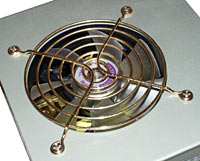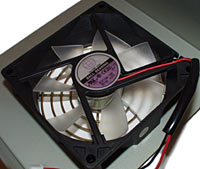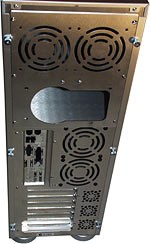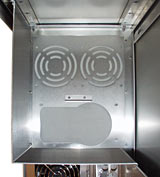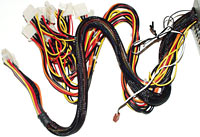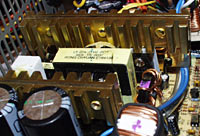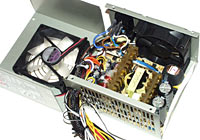
Enermax EG651P-VE power supply
Review date: 20 March 2001.Last modified 03-Dec-2011.
Does your PC need a lot of juice?
I mean, a lot of juice?
Well, here's the Power Supply Unit (PSU) for you.
The Enermax EG651P-VE, now available here in Australia, brings show-off styling to the humble ATX PSU. Two fans - one 90mm, one 80mm. Gold plated fan grilles. Gold anodised internal heat sink. And a monster 550 watt rating, which is enough for a very seriously stacked system indeed.
Given that a 300 watt supply's more than good enough for most PCs, with 350 and 400 watt PSUs around for people with a real stack of drives, 550 would appear to be somewhat ridiculous. But some people need a PSU like this, and I'll explain why in a moment.
For $AU280.50 delivered, the EG651P-VE isn't cheap. Basic yum cha 230 watt PSUs sell for rather less than $AU50. But the Enermax is unlikely to be the most expensive component of any PC that actually needs this much power.
Pretty power
Golden fan grilles, baby.
The two fans in the EG651P are set up to blow air out of the PC, just like the single fan in most other ATX PSUs. Fans in series like this don't give you twice the airflow - each one can only move, at most, as much air as it could by itself, and one is just feeding the other. But series fans do give you a higher static pressure rating, which means the fans are better at dragging air through the case against the resistance of inlet vents and cables and all the other stuff that conspires to keep case airflow low.
The 90mm fan has "VISIBLE BALL BEARING" written on the hub, which is quite correct...
...because the spinning bit's made of translucent plastic, and you can indeed see the ballrace through the hub.
Both this and the ordinary-looking 80mm rear fan are ballraced - ball bearings last longer than sleeve ones - and they're thermostatically controlled so the PSU doesn't sound like a Harrier taking off unless it has to.
The fan layout, by the way, means that if you mount this show-off PSU in a similarly show-off case, the Lian Li PC-70 (which I review here), it'll work fine.
The PC-70's PSU mount area...
...is partially enclosed in an aluminium box...
...like this, and so PSUs with a fan on the bottom will foul the box and not work properly unless you invert the case's PSU mount plate, which'll still leave them trying to move air through a pretty cramped space.
The EG651P doesn't have this problem; its top fan'll face up when it's mounted on the non-inverted plate.
The cable loom.
The black one's the standard ATX motherboard power cable, which has a mesh tube wrap for neatness. As well as it, you get one ATX12V four pin 12 volt booster connector for Pentium 4 motherboards that need it, one six-wire AUX 3.3 and 5V connector for server boards that want it, one power supply fan speed connector for motherboards with a header to match, and one buttload of drive power connectors.
"One buttload", in this case, means two cables each with four Molex-plug standard drive power connectors, and one cable with four Molex plugs and one floppy drive power connector. 11 Molex, one floppy. Unlike most PSUs, this one doesn't give you far more floppy drive power plugs than you need.
The drive power leads are about 109cm long (43 inches), with the first connector after the 500mm mark. This makes it easy to tidy up your cables with ties around the computer's case frame without running out of wire, even in large server cases.
The motherboard power cables are about 65cm long (25.5 inches).
All of the connector contacts are gold plated. To quote the PDF file here, this is "for improving faint resistance and performance".
Well, gold plated contacts are indeed not going to corrode like ordinary tin-plated ones, but unless the contacts on your drives and motherboard are also gold plated - which they won't be - gold will actually give you a lousier contact, over time. Contact of dissimilar metals accelerates corrosion.
The gold contacts will stay pristine - well, unless you wear off the super-thin layer of gold, anyway - but the tin side of the contact will rust faster.
Fortunately, the corrosion will be slow and mild, and even if it's been happening for years, you can get rid of it by just plugging and unplugging the connector to expose some fresh metal. It'll probably make no difference at all to the performance of the PSU. Just don't get the idea that the gold contacts are actually something special.
Crunching numbers
The EG651P's 550 watt rating breaks down into 24 amps on the +12V rail, 46A on the +5V and 40A on the +3.3V. The -5, -12 and +5V standby rails are much lower rated, as usual - 1, 1 and 1.8 amps, respectively. That's not a problem; the main power rails are the only ones that actually need a high current rating.
Multiply out all of the amps and volts from the power rails and you get a clean 650 watts, which is the PSU's peak output rating. It can't actually handle having all of its power rails loaded to their full capacity all the time, though; the total aggregate load has to be below 550 watts, divided among the power rails however you like, up to their individual limits.
A PC's power draw on the different rails depends on what hardware it's using. Different drives load up the +5 and +12 volt rails differently, but ordinary 3.5 inch hard drives only need a few watts in total when they're up to speed. The motherboard'll want a lot of 3.3V current if you're running a somewhat modern CPU and a recent 3D graphics card, and if you've got a forest of 12 volt fans then they can add up to a few amps, too. But no normal PC needs the power the EG651P can deliver.
Abnormal PCs, though, are another matter.
Active CPU cooling is a great way to raise your PSU requirements. People using Peltier effect coolers to chill their CPU below ambient (check out my article here for more information on this) often find themselves having to go with a second power supply. And not necessarily even a standard PC one, if they want to run their Peltier device at more than 12 volts, which many Peltiers need if you want their full heat transfer capacity.
If you are running Peltiers from 12 volts, which can be a good idea if you want to lower the strain on each one and keep their efficiency high, you may find yourself using more than one, in parallel. From 12 volts, high power Peltiers can draw six amps each. Your standard 300 or 350 watt PSU is going to be close to its 12 volt limit if it has to run just one of them, as well as the rest of the PC. But the Enermax will be fine.
Similarly, if you've got truly amazing numbers of 12 volt fans, or if you've made the entirely defensible decision to install a cigarette lighter in your PC's front panel, a whole bunch of spare amps on the 12 volt rail will be desirable.
The Enermax is rated for at least 72% efficiency at full load, which means that when it's delivering 550 watts to other PC components, it's drawing up to 764 watts itself, with the extra 200 watts or so being dissipated as heat in the PSU.
Which explains the twin fans...
...and the big fancy gold anodised heat sinks on the power transistors inside.
Inside the PSU, there's not a fuse in sight. In a serious overload condition, the Enermax is made to just shut down.
Overall
Most computers utterly don't need a PSU like this.
Some people buy high-rated PSUs "just to be sure", but that's not necessarily a great idea. Cheap Taiwanese high power PSUs aren't any more reliable than other cheap Taiwanese PSUs, and may even be worse. That's why they're often difficult to get from reputable dealers - the dead-on-arrival rate's so bad that nobody wants to stock the things.
The Enermax is not a suspiciously cheap Iridescent Frangipani Power Friend PSU with fanciful numbers on the sticker. If you need something that really can deliver 24 amps at 12 volts all the live-long day, this'll do it.
Altogether, if this thing were a car, it'd be a 1974 Cadillac pimpmobile. OK, there's not a lot of room for decoration in the standard ATX PSU form factor, but Enermax are trying, dang it. You know they'd have put purple shag pile on it if they'd been able.
So if your case has neon and blowholes and a fancy fan controller, you're going to want one of these things whether or not you need it.
Everyone else should just know that this thing exists, as an alternative if you'd otherwise need two lesser PSUs.
You've got to ask yourself this question: "Am I worthy?"

